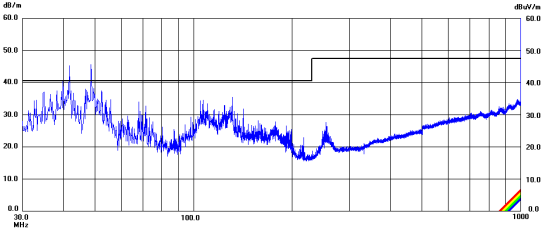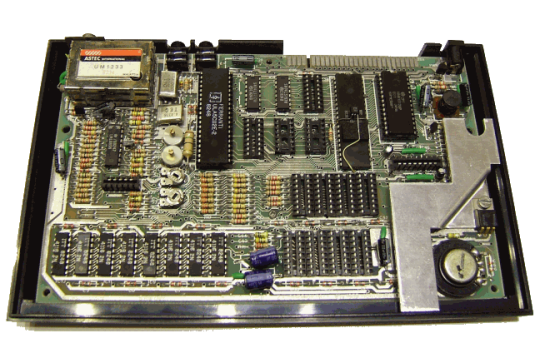Many thanks to everybody who read and commented on last week’s article. Our posting was picked up by The Register and then by Slashdot. In two days, we hosted more than five thousand readers: more footfall than we usually experience in a year.
In the article, I set out to look at what we have learned about radio interference problems and best practice as a result of legislation. Engineers find this an engaging subject, because it has transformed the way that we see the world and how we approach our work. EN55022, on which I focused, is just one of many new regulations that are increasingly affecting our trade. The ZX Spectrum neatly illustrates that we have made genuine progress, and it does so in a refreshing way.
Those who enjoy modifying and continuing the legacy of the computer (and there are many such people) may be a little let down that I didn’t do more. However, I couldn’t please everybody in the space of a blog posting, and I didn’t attempt to. What follows is a consolidation of much of the feedback we received.
EMC isn’t important
It is clear that there are two, and perhaps three, camps in the general argument about electromagnetic compatibility [EMC]. A few correspondents sincerely believe that none of it matters and, in a limited context, they’re right. In the domestic situation, you’re unlikely to encounter a compatibility problem that endangers your life or livelihood. For a lot of people, the fact that home computers would knock out radios, televisions, or toys in the vicinity just blends into part of the nostalgia.
Collision course: the Tandy TRS-80 and MB Games Bigtrak wouldn’t share a room together (thanks to Animats on the Slashdot board for the example)
The other camp, in which I include myself, will contend that good EMC practice is of prime importance. Although I concede that the test limits are arbitrary, we have a duty to invest serious effort in designing equipment that people can use in any way they like, without it disrupting their work or leisure.
That same argument can be extended to rules like RoHS, however clumsily it was introduced, and further into educating engineers about conflict minerals, and particularly tantalum. These things force us to confront the fact that we all shape the world, and the products we design have consequences beyond our influence.
It’s not just about our consciences; it’s good business. What might have been novel and forgivable in the 1980s, when all electronic equipment tended to be a little shambolic and every user was a pioneer, is not so endearing in younger products. Customers today are more sophisticated and less forgiving about environmental and ethical issues, factory conditions, technical problems, even delays in shipping, and we have to be at least as sophisticated as they are.
There is a third camp, whose argument, succinctly, is that a few cowboys spoil everbody else’s fun. Telecommunications products, for example, still run roughshod over EMC regulations because certain products, that transmit radio as an essential part of their function, are exempt from large parts of EN55022. Today, when I plug my cordless phone into the wall, it knocks out the radio on the other side of the room. It’s the switch mode power supply that does this, because the system is exempt and it costs a few cents to buy components that quell the energy it’s emitting.
These issues remind us of the bad old days, but we should set our own sights higher. Let us imagine if every competitive advantage was justified, irrespective of the means, just because nobody had legislated otherwise. We would all be designing dreadful equipment, avoiding our taxes, destroying the world around us, and cynically manipulating and reinterpreting the rules to suit ourselves. Some people do this, but most people don’t, which is why we have lasted this long as a species.
It’s a moot point these days, though: if we don’t meet EMC requirements, we don’t have a product we can sell.
The Metal Box Scenario
 Screening: a large example of a screening can; a heat sink on the Issue 6a Spectrum that might have been a shield but wasn’t; a sprayed can in a spray can.
Screening: a large example of a screening can; a heat sink on the Issue 6a Spectrum that might have been a shield but wasn’t; a sprayed can in a spray can.
Many correspondents pointed to the Faraday Cage. Simply make the case out of cast metal, or coat the inside with a special paint, contrive a method whereby this can be earthed, and radio signals can no longer enter or leave. You suddenly have a compliant product. Simple, right?
It depends. If you’re retrofitting one computer, or you’re making a few dozen of a new product, it is indeed simple: you control the process, you dictate the quality of the result, and you are selling your products or services at enough of a profit that the cost of a can or two of conductive spray paint presents no difficulty. You may still have problems with your cables radiating, though.
If you’re contracting your manufacturing and knocking out tens of thousands of products, though, there are big problems with this kind of technique. Use conductive plastics or cast metal and you change the finish of your product, you accelerate the wear on your tools, and you raise material costs. Use a spray coating, and you must accept that a good proportion of your plastics will be rejected because the paint finish is unacceptable in one way or another. You create a new quality control step, and a new manufacturing process where your equipment must be coated and dried, which impacts on the production line. Aside from having to pay for the extra labour, suddenly you have to store case materials very carefully on massive racks of shelving for several hours while they dry. You’re paying for this time, this floor space, and this temporary storage.
That’s why we accept plastic cases in mass production, and design our products so that the enclosure doesn’t matter. Faraday cages still have their place in modern electronics: if you look inside a mobile phone, you’ll see them soldered to the printed circuit board to protect or defend against selected devices. We can’t enclose everything we make in metal cases, or it would price us out of certain markets entirely, so we find other ways to make our products comply.
Plus ça change
When is a Spectrum not a Spectrum? My attention has been directed towards a number of novel retrofits and research products. Some of these are worth a look:
- José Martinez’s incredible redesign, with the ULA in discrete logic
- At the risk of repetition, there is Chris Smith’s Harlequin project.
- Mike Stirling puts a ZX Spectrum on an Altera FPGA.
- Brian Smith’s case mod is fun, but definitely not in the spirit of conservation.
As many correspondents point out, we can make an impact on radiated emissions if we tinker around the edges. The failure I described as ‘abject’ may be ameliorated with a few simple modifications. Perhaps it would then pass; perhaps it wouldn’t. I would have liked to try these, but unfortunately didn’t have the time.
If we allowed ourselves a more drastic redesign, we’d have a device that behaves like a Spectrum, but when would it cease to be one? If we change the RAM, so it no longer requires those extra power supplies, and then we disable them, is it still a Spectrum? If we change the 7805 regulator for something that doesn’t throw away about 60% of the input power, then remove the heat sink, is it still a Spectrum? Do these conservation projects really preserve the Sinclair legacy?
An old computer is what it is: a product of the market, engineers, and achievements that produced it. These days, a good engineer could create a passable version of this computer using off-the-shelf components and software in a couple of weeks. It’s easy to redesign in hindsight, when technology has moved on and improvements are cheap and even obvious — that’s another article. But in 1982, making a Spectrum was a different order of challenge.
There were five major modifications of the ZX Spectrum’s electronics during its production for reasons of cost, yield, and quality, and by the end they had a much better product. Most of the area on a ZX Spectrum motherboard was taken up by RAM and the electronics required to access it: something you could now do in two or three square centimetres of board space. In 1982, you couldn’t make a computer with a four-layer board economically. Today it is a trivially simple process.
Coda
The abysmal video output and the lack of memory of my current Spectrum drives me a little crazy. I’ve also forgotten how slow the BASIC is, which must be why I decided, at the age of ten, to teach myself assembly language.
While it’s tempting to take this and all my correspondence on board, be influenced by latter-day add-ons such as divIDE, and produce another almost-Spectrum in the manner intimated by my previous post and the links above, that would involve an awful lot of time that I don’t currently have. It’s expensive to make the first one properly, and I’m not certain there’ll be a market for others.
So, what am I going to do with my Issue 2 Spectrum? The next thing I intend to do is to take another look in the EMC chamber to see if the simple modifications I suggested in the last article will make it pass, as there’s a relatively low risk of messing up my computer if I stick to some fairly basic changes. I’ll get back to you in March, when the snow has melted and we’ve booked a little more time in the chamber.
For the next few postings, though, forgive me if I steer the subject back to Focusrite.
Photo credits:TRS-80 / Bigtrak / P&O container (the article is great) / Issue 6a Spectrum / Nickel spray.












